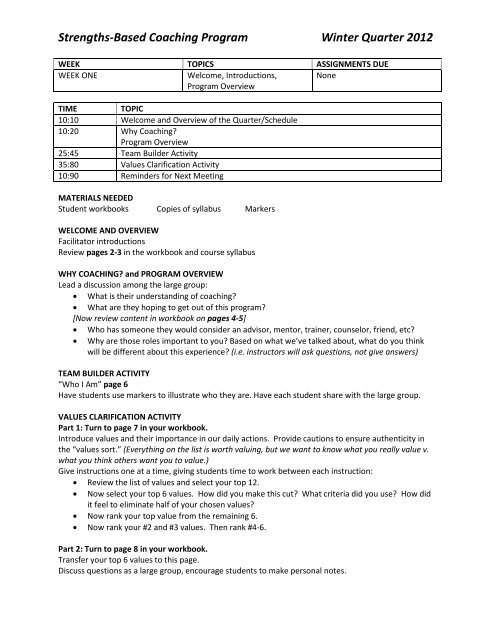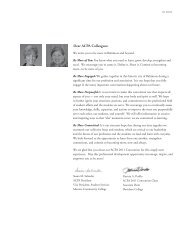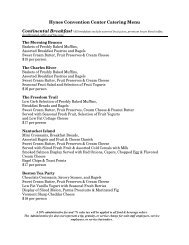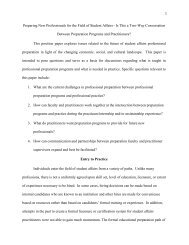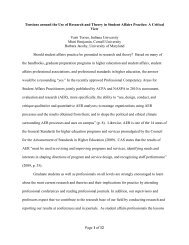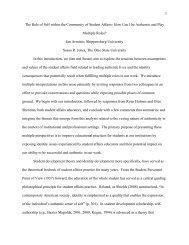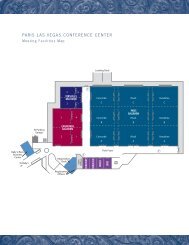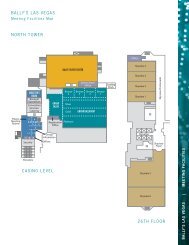Strengths-Based Coaching Program Winter Quarter 2012
Strengths-Based Coaching Program Winter Quarter 2012
Strengths-Based Coaching Program Winter Quarter 2012
You also want an ePaper? Increase the reach of your titles
YUMPU automatically turns print PDFs into web optimized ePapers that Google loves.
<strong>Strengths</strong>-<strong>Based</strong> <strong>Coaching</strong> <strong>Program</strong> <strong>Winter</strong> <strong>Quarter</strong> <strong>2012</strong><br />
WEEK TOPICS ASSIGNMENTS DUE<br />
WEEK ONE Welcome, Introductions,<br />
<strong>Program</strong> Overview<br />
None<br />
TIME TOPIC<br />
10:10 Welcome and Overview of the <strong>Quarter</strong>/Schedule<br />
10:20 Why <strong>Coaching</strong>?<br />
<strong>Program</strong> Overview<br />
25:45 Team Builder Activity<br />
35:80 Values Clarification Activity<br />
10:90 Reminders for Next Meeting<br />
MATERIALS NEEDED<br />
Student workbooks Copies of syllabus Markers<br />
WELCOME AND OVERVIEW<br />
Facilitator introductions<br />
Review pages 2-3 in the workbook and course syllabus<br />
WHY COACHING? and PROGRAM OVERVIEW<br />
Lead a discussion among the large group:<br />
• What is their understanding of coaching?<br />
• What are they hoping to get out of this program?<br />
[Now review content in workbook on pages 4-5]<br />
• Who has someone they would consider an advisor, mentor, trainer, counselor, friend, etc?<br />
• Why are those roles important to you? <strong>Based</strong> on what we’ve talked about, what do you think<br />
will be different about this experience? (i.e. instructors will ask questions, not give answers)<br />
TEAM BUILDER ACTIVITY<br />
“Who I Am” page 6<br />
Have students use markers to illustrate who they are. Have each student share with the large group.<br />
VALUES CLARIFICATION ACTIVITY<br />
Part 1: Turn to page 7 in your workbook.<br />
Introduce values and their importance in our daily actions. Provide cautions to ensure authenticity in<br />
the “values sort.” (Everything on the list is worth valuing, but we want to know what you really value v.<br />
what you think others want you to value.)<br />
Give instructions one at a time, giving students time to work between each instruction:<br />
• Review the list of values and select your top 12.<br />
• Now select your top 6 values. How did you make this cut? What criteria did you use? How did<br />
it feel to eliminate half of your chosen values?<br />
• Now rank your top value from the remaining 6.<br />
• Now rank your #2 and #3 values. Then rank #4-6.<br />
Part 2: Turn to page 8 in your workbook.<br />
Transfer your top 6 values to this page.<br />
Discuss questions as a large group, encourage students to make personal notes.
<strong>Strengths</strong>-<strong>Based</strong> <strong>Coaching</strong> <strong>Program</strong> <strong>Winter</strong> <strong>Quarter</strong> <strong>2012</strong><br />
REMINDERS FOR NEXT WEEK<br />
Announce assignments for next week<br />
• SQ Assessment – bring results with you (theme report – 5 paragraphs)<br />
• Preface – Ch.2 in SQ book<br />
• Ch.3 intro and the “Affirming ___” for your 5<br />
• Ch. 5 Intro and “Developing ___” for your 5<br />
Please bring your workbook to each meeting for the rest of the quarter
<strong>Strengths</strong>-<strong>Based</strong> <strong>Coaching</strong> <strong>Program</strong> <strong>Winter</strong> <strong>Quarter</strong> <strong>2012</strong><br />
WEEK TOPICS ASSIGNMENTS DUE<br />
WEEK TWO <strong>Strengths</strong>Quest Part 1 <strong>Strengths</strong>Quest assessment results (bring to meeting)<br />
Preface – Ch.2 in SQ book<br />
Ch.3 intro and the “Affirming ___” for your 5<br />
Ch. 5 Intro and “Developing ___” for your 5<br />
TIME TOPIC<br />
5:5 Check-In and Meeting Overview<br />
80:85 <strong>Strengths</strong>Quest, part 1<br />
5:90 Reminders for Next Meeting<br />
MATERIALS NEEDED<br />
PPT of <strong>Strengths</strong>Finder awareness workshop, blank paper for each student for handwriting demo<br />
CHECK-IN AND OVERVIEW<br />
How is everyone doing this week? Any new thoughts about our values sort?<br />
STRENGTHSFINDER, PART ONE<br />
Topics to Cover:<br />
• Background on <strong>Strengths</strong> philosophy<br />
• Myths of weakness-building<br />
• 4 Domains (pg. 13 in workbook)<br />
• ¼ - ½ of Themes<br />
1. Turn to page 9 in your workbook and complete a brief reflection to get started. Share comments<br />
with the large group.<br />
2. <strong>Strengths</strong>Quest workshop. (Slides divided below)<br />
• 1-3: Mel, Intro and “Getting the Most Out of Your Report”<br />
• 4-8: Jen, Why <strong>Strengths</strong>? Left Hand/Right Hand Demo, Talent v. <strong>Strengths</strong><br />
• 9-11: Mel, Rudy, Michael Jordan, and Michael Phelps<br />
• 12-14: Jen, Weakness-Fixing v. <strong>Strengths</strong>-Building<br />
• 15-18: Mel, Dealing with weaknesses<br />
• 19-23: Jen, The Assessment<br />
• 24 – 25: Mel, The Four Domains<br />
• 26-63: Jen kicks off the 34 themes, alternate by theme?<br />
3. Turn to page 10 in your workbook and begin filling in the chart about your <strong>Strengths</strong> and how<br />
you use them. Bring this completed to our next meeting.<br />
REMINDERS FOR NEXT MEETING<br />
To Do for next week:<br />
• Complete “My <strong>Strengths</strong> and How I Use Them” table.<br />
• Talk with 3 people about your top 5 themes. Write a brief reflection about their reaction to<br />
your results (page 11).<br />
• Read Ch. 4 All
<strong>Strengths</strong>-<strong>Based</strong> <strong>Coaching</strong> <strong>Program</strong> <strong>Winter</strong> <strong>Quarter</strong> <strong>2012</strong><br />
WEEK TOPICS ASSIGNMENTS DUE<br />
WEEK THREE<br />
<strong>Strengths</strong>Quest part 2 Completed table<br />
Personal reflection<br />
Ch. 4 All<br />
TIME TOPIC<br />
5:5 Check-In and Meeting Overview<br />
80:85 <strong>Strengths</strong>Quest, part two<br />
5:90 Reminders for Next Meeting<br />
MATERIALS NEEDED<br />
Pens, markers, crayons, paper, etc. for creative modeling<br />
Copies of class strengths map for each student<br />
CHECK-IN AND OVERVIEW<br />
How is everyone doing this week? Any new or updated thoughts about <strong>Strengths</strong>?<br />
STRENGTHSQUEST PART TWO<br />
Topics to Cover:<br />
• Brief re-cap from last week<br />
• ½ - ¾ of Themes<br />
• Theme Dynamics<br />
Your homework from last week was to share your results with at least three other people and write a<br />
brief reflection on their reaction. Share reflections with the group.<br />
<strong>Strengths</strong>Quest workshop. Include “Talent Line Up” activity from SQ Activity Book (from<br />
strengthsquest.com<br />
Refer to pages 13-16 for additional resources (theme domains, team map, reference card).<br />
Turn to page 12 in your workbook. To continue our conversation about theme dynamics, please choose<br />
one of the two options listed to model the interaction among your personal strengths. Share results<br />
with the group.<br />
Reflection:<br />
Why would we start with <strong>Strengths</strong> for this program?<br />
What has been one take-away for you with respect to <strong>Strengths</strong>?<br />
As we move through the rest of the quarter, we’ll continue to revisit <strong>Strengths</strong> as a foundation for our<br />
future conversations.<br />
REMINDERS FOR NEXT MEETING<br />
Next week we’ll begin discussing goals.<br />
Reading Due: Ch. 6 All<br />
Ch. 7 Intro and “___ in Academics” for your 5<br />
Ch. 10 Intro and “___ in Careers” for your 5
<strong>Strengths</strong>-<strong>Based</strong> <strong>Coaching</strong> <strong>Program</strong> <strong>Winter</strong> <strong>Quarter</strong> <strong>2012</strong><br />
WEEK TOPICS ASSIGNMENTS DUE<br />
WEEK FOUR<br />
Discussion of Goals Ch. 6 All<br />
Ch. 7 Intro and “___ in Academics” for your 5<br />
Ch. 10 Intro and “___ in Careers” for your 5<br />
MATERIALS NEEDED<br />
CLASS OUTLINE<br />
1. Discussion of Personal Goals<br />
• What is the core issue<br />
• Defining goal as a 90-day project<br />
• Balance of challenging and attainable<br />
• How do your strengths play into your goal setting?<br />
• Make it snappy!<br />
• Creating Measurements<br />
2. Discussion of where you are now<br />
• What do you already have to get to your goal?<br />
• What do you still need?<br />
INSTRUCTOR NOTES<br />
Introduction (5 Min)<br />
• Now that we’ve discussed your strengths, it is time to focus on how your strengths can help you<br />
attain and reach goals.<br />
• For example, if I am an achiever, so I could think that because I understand I work best when I<br />
have checklists, it can help me break down what I need to do to ensure a goal is met.<br />
What is a goal worth going for? (30 Minutes)<br />
• It is one that focuses on the issue that will make the most difference to you<br />
• Sometimes to figure out this goal, it takes a ton of self-honesty<br />
Brainstorming: Have students brainstorm a goal they believe is worth going for – have them think<br />
about major, relationships, student involvement, personal, career, creative. They should be thinking<br />
of this as a goal they could possibly work toward during the quarter/semester. (5-10 Minutes)<br />
Group Discussion: What are some goals that came to mind?<br />
Pg. 17 Activity:<br />
• Think about what is at the core of each of the goals that came to mind. If it’s an academic<br />
goal, for example, and you want to “get an A” , the core issue could be that you don’t<br />
understand a particular subject and need to increase your knowledge.<br />
• Write all core issues that come to mind under the given focus area. Then have them<br />
formulate goals for each focus area out of those core issues. (5 – 10 Minutes).<br />
Defining goal as 90 Day Project (15 min) – Pg. 18<br />
• This time frame is enough time for there to be an impact on your life, but also to maintain<br />
motivation and excitement.
<strong>Strengths</strong>-<strong>Based</strong> <strong>Coaching</strong> <strong>Program</strong> <strong>Winter</strong> <strong>Quarter</strong> <strong>2012</strong><br />
• Now, remember, you will be committing to this goal for 90 days<br />
o The goal that you’ve created now can be part of a bigger goal – avoid going too big.<br />
Be open to being challenged<br />
• The best goal is one you don’t know how you’re going to achieve – you just sense you’ll<br />
be able to work it out if you really apply yourself<br />
• One way to challenge yourself if to ‘Up the ante.’ What does that look like for you?<br />
Make sure it’s achievable<br />
• Remember, even though it’s a stretch, it needs to not be too big<br />
• You may start with a goal that you think is achievable but in a few weeks you realize it’s<br />
not… it’s OK to change your goal along the way.<br />
Make it Snappy<br />
• This is your motivation for CHANGE!<br />
• You’ll be saying it to yourself over the next weeks – so make it short and snappy!<br />
• Make sure to tailor the goal so it will excite you!<br />
Creating Measurements:<br />
• How will you hold yourself accountable and be able to personally measure this goal?<br />
• Is it related to another time in your life? Is it a percentage? Is it a numeric scale? Is it a<br />
physical outcome?<br />
• Whatever it is – it’s got to be the right way to measure for YOU and keep YOU motivated.<br />
Small Group Activity: Now that I’ve talked to you about goal setting – it’s time to talk to each other.<br />
Get students into 4 groups of 4. Have each student go around and answer these questions (12 minutes):<br />
• What is the goal you’ve decided to focus on?<br />
• What are some challenges you may face along the way?<br />
• Do you feel it’s achievable?<br />
• How can you make it snappy to keep you motivated?<br />
• How are you measuring this goal?<br />
• How do your <strong>Strengths</strong> help you achieve this goal?<br />
Turn discussion to the large group: What are some goals and measurements you discussed in your<br />
small group? How do you think <strong>Strengths</strong> can play a role in helping you achieve them? (5-10 min)<br />
Back to Small Groups: Where are you right now? (20 min)<br />
Now that we’ve talked about goal setting, let’s switch gears to where we are right now, in the<br />
present.<br />
Have students get back into their groups of 4 to discuss the following:<br />
• What do you already have to get you to your goal?<br />
• What do you still need?<br />
Turn discussion to large group: Ask student how they are feeling about all of this. What do they<br />
already have to help them achieve their goals? What do they still need?<br />
Homework – Pg. 19-20 Move into talking about reflection and the importance of writing the goal down.<br />
Finalize the focus and wording of your “goal worth going for” before next week’s meeting.
<strong>Strengths</strong>-<strong>Based</strong> <strong>Coaching</strong> <strong>Program</strong> <strong>Winter</strong> <strong>Quarter</strong> <strong>2012</strong><br />
WEEK TOPICS ASSIGNMENTS DUE<br />
WEEK FIVE<br />
Visualizing Success p. 19-20, Finalize your “goal<br />
worth going for”<br />
MATERIALS NEEDED<br />
Pens, markers, crayons, etc. for drawing<br />
Sign-up Sheet for 1:1 Meetings<br />
OUTLINE<br />
1. Check in (10 min)<br />
a. Each student shares finalized goal with the group.<br />
b. Questions to the group: How do you feel about your goal?<br />
c. Anything they noticed in the past week re: their goal, strengths, etc?<br />
2. Present concept of “Visualizing the Goal” (2 min)<br />
a. Last week we spoke a lot about setting up an attainable goal and noting what goes in to<br />
choosing your goal. This week, we are focusing on visualizing the goal and maybe the<br />
gaps in this goal.<br />
b. Everyone has a different way of visualizing their goals. Today, we are going to create<br />
visualization through drawing.<br />
3. Pg. 21 - Bridge Drawing (approx. 1 hour total):<br />
a. (15-20 min) Drawing: Students will draw a bridge that represents the goal they have<br />
selected and the various components and considerations in work on and reaching that<br />
goal. Directions are as follows:<br />
i. Leave the inner critic behind<br />
ii. You can draw this however you would like to – it can be concrete or an abstract<br />
representation<br />
iii. Where are you on your bridge?<br />
iv. Where do your challenges lie?<br />
v. What are your support systems?<br />
b. (10-15 min) Share in small groups: Have students show and explain their drawings to<br />
each other, ask questions of each other and offer feedback.<br />
c. (10-15 min) Share in large group: Bring the discussion back to the large group – What<br />
are some commonalities found in each group with their drawings? What are people’s<br />
support systems? What are the gaps or challenges that were found? Would anyone like<br />
to share their bridge drawing with the group? How do we feel your <strong>Strengths</strong> can play<br />
out with your visualization?<br />
4. What’s In The Gap? (5 min)<br />
a. Present concept:<br />
i. Now that you have a visual representation of where you are and where you<br />
want to be with your goal, the next step is to uncover “what’s in the gap”<br />
between those two points.<br />
ii. It might be personal (courage, confidence) or external (available resources,<br />
time). The answer tends to be something that we can’t see for ourselves at<br />
first.<br />
iii. If the answer to “what’s in the gap” is easy for you, then maybe your goal is a<br />
little too easy.
<strong>Strengths</strong>-<strong>Based</strong> <strong>Coaching</strong> <strong>Program</strong> <strong>Winter</strong> <strong>Quarter</strong> <strong>2012</strong><br />
iv. Having an outside perspective can help you identify what’s in your gap and how<br />
best to begin addressing it. Taking time to identify the deeper issues and the<br />
bigger picture can help set you up for bigger success later.<br />
b. Personal reflection: What’s in the Gap? Take a few moments to think about what’s in<br />
your gap. FOR HOMEWORK: p. 22-23: Complete this for next week’s meeting. Consider<br />
how you can get over the gaps, what is really stopping you, and how can your <strong>Strengths</strong><br />
help overcome that.<br />
5. Check-in (5 min):<br />
a. Ask the group how they are feeling about their goals after today’s class<br />
6. 1:1 Meeting Signups (10 min)<br />
a. Please sign up for a 1:1 meeting with one of the facilitators. Times are available over<br />
the next two weeks.<br />
Homework for next time:<br />
Read Ch. 8-9 ALL<br />
p.22-23 in workbook
<strong>Strengths</strong>-<strong>Based</strong> <strong>Coaching</strong> <strong>Program</strong> <strong>Winter</strong> <strong>Quarter</strong> <strong>2012</strong><br />
WEEK TOPICS ASSIGNMENTS DUE<br />
WEEK SIX<br />
Creating a Plan for Success Pg. 22-23 “What’s in the Gap”<br />
1:1 Meetings with Facilitators Ch. 8 All<br />
Ch. 9 All<br />
MATERIALS NEEDED<br />
Markers<br />
Flip-chart paper<br />
Sign-up Sheet for 1:1 Meetings<br />
OUTLINE<br />
Check-in (5 Minutes)<br />
• How is everyone doing this week?<br />
• How are we feeling about our goals now? How have we continued to visualize them?<br />
Follow up on the gap (Time TBA)<br />
• In pairs or trios, share your list of what’s in your gap. Solicit feedback from your group about<br />
common themes they see.<br />
• Discuss what you can do, and how your <strong>Strengths</strong> can help you address the gaps.<br />
How to accomplish your goal (10-20 minutes)<br />
• This week, we’re focusing on HOW to accomplish your goal. What do you need to do to make<br />
sure you actually get what you need done?<br />
• This part of our process involves researching options.<br />
o How many of you learned to ride a bike as a child? How many of you haven’t ridden a<br />
bike in over a year (or more), but know that you could get back on that bike with no<br />
problem?<br />
o That’s because as we learn new things, our brain creates pathways between neurons<br />
that become worn and familiar. It’s in this way we can pick up something again, like<br />
riding a bike, even after a long break from the activity.<br />
o The up-side is that this helps us live without constantly having to re-learn things anew<br />
every time we do them.<br />
o The down-side is that this creates habits, even habitual ways of thinking, that unless we<br />
are forced to change will be the way we do things automatically forever.<br />
o When researching your options, you are choosing the paths that you want to take to<br />
accomplish your goal. You get to tackle the issues that are in the way to achieving your<br />
goal, instead of just doing things the way you’ve always done them.<br />
Activity: Planning an event (30 minutes)<br />
• The class will split into two groups of 8.<br />
• Must accomplish the given scenario to accomplish a given task<br />
• Scenario (page 25): You are a student organization at Ohio State that wants to put on an event<br />
in 3 weeks for the student body. Taking what you know from the university as well as what you<br />
know about goal setting from this experience, you must make a plan describing the event, and<br />
what you need to do to make sure the event takes place successfully. You will have 15 minutes<br />
in your group to brainstorm and develop action steps to make the event possible.
<strong>Strengths</strong>-<strong>Based</strong> <strong>Coaching</strong> <strong>Program</strong> <strong>Winter</strong> <strong>Quarter</strong> <strong>2012</strong><br />
• Groups will mark their event on large post-it notes using markers. After the 15 minutes have<br />
concluded, students will be asked to present their events, and most importantly focusing on<br />
HOW they will make sure the event will happen. (15 minutes)<br />
• Debrief with group (15 – 20 Minutes):<br />
o What do you think you learned from this activity?<br />
o From this activity, what insight did you gain about the process of achieving the task at<br />
hand? What was challenging? What was easy to navigate?<br />
o Related to our discussion about doing your research, do you feel because you know the<br />
way in which Ohio State operates you were at an advantage?<br />
o How do you feel this activity translates into what you are individually trying to<br />
accomplish with your own goal setting?<br />
Wrap up – Look to Action Steps for next week (page 26). Any questions, lingering thoughts?<br />
Please sign up for a 1:1 meeting with one of the facilitators. Times are available this week and next.
<strong>Strengths</strong>-<strong>Based</strong> <strong>Coaching</strong> <strong>Program</strong> <strong>Winter</strong> <strong>Quarter</strong> <strong>2012</strong><br />
WEEK TOPICS ASSIGNMENTS DUE<br />
WEEK SEVEN<br />
Confirming Choices and<br />
Addressing Doubts<br />
1:1 Meetings with Facilitators<br />
Page 26 – Action Station<br />
MATERIALS NEEDED<br />
Copy of Ch. 7 in Rock’s “Personal Best” book for each student<br />
Markers<br />
Flip-chart paper<br />
OUTLINE<br />
This week we will discuss two main topics:<br />
• Confirming your choices<br />
• Creating a plan for success (talking back to that little voice called ‘doubt’)<br />
Check in (5-10 Minutes)<br />
• Any lingering thoughts from last week’s class meeting? How are you feeling this week about<br />
reaching your goal?<br />
Narrowing your options to make a choice (20 minutes)<br />
• Lecturette – confirming that the choices you’ve made so far are helping you make progress<br />
(developing and checking against parameters to make sure you’re on the right track), and<br />
“mourning” the roads not taken<br />
• Debrief with class – How do you see these playing a role in your goal setting? What is it that<br />
may serve as the biggest mourning piece for you as you move toward your goal?<br />
o What choices have you made regarding the pursuit of your goal to this point?<br />
o What have you actively decided to leave behind in order to devote more<br />
time/energy/focus to your goal?<br />
o Are you “over” what you have had to leave behind, or are you still thinking<br />
about/stressing about your decision?<br />
Creating a plan for success (talking back to that little voice called ‘doubt’) (45 minutes)<br />
• Pass out copies of Ch. 7 of David Rock’s “Personal Best.”<br />
• Introduce the following concepts: Get Support, Get Clear, Get on Time, Make Way for Success,<br />
Be on the Lookout for Success, Get Educated, and Get Serious (WB page 27)<br />
• Have students read the chapter silently to themselves, making notes in their workbooks on<br />
relevant points for each concept. How does each concept relate to their goal?<br />
• Discuss responses to page 27 with a partner<br />
• Debrief with the class: What is a take home point for you in learning about these seven steps to<br />
success? How do you feel your <strong>Strengths</strong> can play into creating this plan? What do you find<br />
most helpful? What could pose as most challenging?<br />
Wrap up: Any last thoughts? Questions? Talk about Action Steps (pages 28-29) for next week.
<strong>Strengths</strong>-<strong>Based</strong> <strong>Coaching</strong> <strong>Program</strong> <strong>Winter</strong> <strong>Quarter</strong> <strong>2012</strong><br />
WEEK TOPICS ASSIGNMENTS DUE<br />
WEEK EIGHT<br />
Taking Action and<br />
Managing Change<br />
p. 28-29 Action Station<br />
TIME TOPIC<br />
5:5 Check-In and Meeting Overview<br />
15:20 Taking Action discussion<br />
15:35 Managing Change and Resistance discussion<br />
30:65 Jet Fighter<br />
15:80 Reflection / Bringing It All Together<br />
5:85 Reminders for Next Meeting<br />
MATERIALS NEEDED<br />
CHECK-IN AND OVERVIEW<br />
How is everyone doing this week? How are your plans for success?<br />
TAKING ACTION (WB 30)<br />
Lecture/Discussion:<br />
• The hardest part is just starting…<br />
o Worrying about doing something decreases energy level, while just doing it increases<br />
energy level<br />
o Worry, anxiety, and time spent in inaction may be wasted time / doesn’t yield results<br />
• Thinking about taking action, and taking action are two different things<br />
o Don’t discount thinking, but don’t be debilitated by it either<br />
o Put the necessary thought into your plan for action, then implement that plan<br />
MANAGING CHANGE (WB 30)<br />
Lecture/Discussion:<br />
• Learning even basic things for most people is somewhere between mildly uncomfortable and<br />
completely overwhelming<br />
o Going through this process where making changes can have a potentially huge impact<br />
on your life may be somewhere between a little confronting and completely terrifying<br />
• This process is challenging, but it’s helpful to not let your emotions overwhelm you<br />
• Be prepared not only for change, but also the inevitable resistance to that change<br />
o Resistance from yourself<br />
o Recognize your breakthroughs / small wins<br />
o Resistance from others<br />
JET FIGHTER ACTIVITY<br />
Divide into teams of 5 people each for this activity<br />
REFLECTION / BRINGING IT ALL TOGETHER<br />
How did you feel during the Jet Fighter activity?<br />
Did you feel prepared to take action in pursuit of the goal at hand?<br />
Did you experience resistance in your progress, or breakthroughs in your group process?
<strong>Strengths</strong>-<strong>Based</strong> <strong>Coaching</strong> <strong>Program</strong> <strong>Winter</strong> <strong>Quarter</strong> <strong>2012</strong><br />
This activity is not too different from the situation you are in now…you have a goal worth going for, you<br />
have individual responsibilities, and you are working within a larger group or context that is essential for<br />
your success.<br />
If the frustrating feelings you experienced as part of this activity are only a simulation of the real thing,<br />
how will you feel when you’re pursuing YOUR goal and you run into similar frustrations?<br />
REMINDERS FOR NEXT WEEK<br />
Focus on the Action Station (pages 31-32) for this week, especially consider how your <strong>Strengths</strong> play into<br />
your selected actions, overcoming resistance, and leading to your breakthroughs.<br />
Consider one way to celebrate a breakthrough and commit to do that when you reach that milestone.
<strong>Strengths</strong>-<strong>Based</strong> <strong>Coaching</strong> <strong>Program</strong> <strong>Winter</strong> <strong>Quarter</strong> <strong>2012</strong><br />
JET FIGHTER<br />
Objectives<br />
• To show the importance of communication.<br />
• To demonstrate how effective communication can lead to positive outcomes.<br />
• To enhance the skills of diplomacy, negotiation, planning and problem solving.<br />
• To begin to foster collaboration among organization members and leaders.<br />
•<br />
10/10 Introduction to Communication<br />
• Facilitator asks:<br />
o Why is communication important in our<br />
organization? In any organization?<br />
o What are some of the obstacles of effective<br />
communication?<br />
40/50 The A B C Exercise<br />
• The group’s objective is to successfully complete<br />
their task.<br />
Facilitator Note: The room will<br />
need to be pre-set into the jet<br />
fighter formation. When<br />
students return to the room,<br />
they should select a chair and<br />
not disturb the formation.<br />
Facilitators should assist in<br />
setting the room with the<br />
desired numbers of formations.<br />
Scrap paper should be placed<br />
at each chair for written<br />
communication.<br />
• Participants will need to follow the instructions on their individual sheets to<br />
complete the task.<br />
• All communication will be in writing only.<br />
• Participants will know when they have successfully completed the exercise.<br />
• They will have twenty minutes to complete their task.<br />
• Presenters will need to determine the number of jet fighter formations to<br />
maximize student participation, trying as much as possible to have as few<br />
students in the observer role as possible.<br />
M<br />
A<br />
B O<br />
C D E
<strong>Strengths</strong>-<strong>Based</strong> <strong>Coaching</strong> <strong>Program</strong> <strong>Winter</strong> <strong>Quarter</strong> <strong>2012</strong>
<strong>Strengths</strong>-<strong>Based</strong> <strong>Coaching</strong> <strong>Program</strong> <strong>Winter</strong> <strong>Quarter</strong> <strong>2012</strong><br />
Prepare on flipchart in advance:<br />
A, B, C, D, E, are the participants<br />
M is the messenger<br />
O is the observer<br />
A can communicate with B<br />
B can communicate with A or C or D or E<br />
C, D, E, can only communicate with B<br />
All communication must be in writing, in a memo format<br />
TO:<br />
FROM:<br />
• If incorrectly addressed, the messenger can either return it without saying<br />
anything, or put it in their pocket, or throw it away. The point here is that<br />
sometimes messages are given incorrectly, not addressed correctly, or given to<br />
the wrong person...and the end result is that they don’t get “delivered”.<br />
• The observer just watches the action and offer comments during discussion. A<br />
good basic question is “how was this exercise real?” Another good question to<br />
ask is “what did you do that helped (or hindered) the completion of the exercise?”<br />
• At the conclusion of the exercise, process the following:<br />
o What were the observations of the observer?<br />
o How did this game make you feel?<br />
o Who felt frustrated? Why?<br />
o How did the person in the front feel thinking that everyone had all of the<br />
information?<br />
o How did the people in the rear feel?<br />
o How did the person in the middle feel?<br />
o If anyone had his or her paper ripped up, how did that feel? What were<br />
your initial thoughts?<br />
o What was the significance of having the communication formatted a<br />
certain way?<br />
o When time is limited, how do we ensure effective communication takes<br />
place?<br />
15/65 Collaboration<br />
• At this point the presenter should shift the discussion toward collaboration/<br />
o Have each jet fighter circle their chairs and respond to the following<br />
questions:<br />
• Identify specific times when there is communication breakdown<br />
within the organization.<br />
• Are there common themes in the breakdowns? Specific areas of<br />
concern?
<strong>Strengths</strong>-<strong>Based</strong> <strong>Coaching</strong> <strong>Program</strong> <strong>Winter</strong> <strong>Quarter</strong> <strong>2012</strong><br />
• What strategies can be implemented to prevent communication<br />
breakdown in the future?<br />
• Presenter should bring the large group back together and ask if any groups are<br />
willing to share their responses.<br />
o What role does communication play in promoting and resolving the issues<br />
in our organization?<br />
o How then can we work to resolve some of the issues?<br />
o How do the organization leaders provide leadership through the process?<br />
o How will they know when they’ve been successful?<br />
10/75 Closure<br />
• We have seen that it is important to communicate our ideas, values, etc. to<br />
people so that everyone around us knows what is going on and what we are<br />
thinking.<br />
• As leaders, it is even more crucial for us to have good communication skills, to<br />
be able to communicate to others what is taking place within our organizations.<br />
• We have also seen that it is important to communicate to others in leadership<br />
positions when we do not know what is going on within our organizations,<br />
campus, and community.
<strong>Strengths</strong>-<strong>Based</strong> <strong>Coaching</strong> <strong>Program</strong> <strong>Winter</strong> <strong>Quarter</strong> <strong>2012</strong><br />
Instructions<br />
PERSON A<br />
JET FIGHTER COMMUNICATION EXCERCISE<br />
In this project, you are A. The project reporting structure is as follows: B reports to you; C, D, and E,<br />
report to B.<br />
Each of you has been given five symbols, each of which is one of six familiar symbols. Your job is to find<br />
out which one of the six symbols is held in common. You must finish this job in 20 minutes. You may<br />
communicate with B only through the exchange of written notes. B may exchange notes with you and C,<br />
D, and E. Persons C, D, and E may exchange notes with B only. No other communication is permitted.<br />
To elaborate:<br />
• There are six unique symbols.<br />
• Each person has five of these six possible symbols.<br />
• There are four copies of five of the symbols.<br />
• There are five copies of one of the symbols.<br />
• You are to determine which one symbol all five persons hold.<br />
• Your symbols are as follows:<br />
= ÷ Σ & ?<br />
Instructions<br />
PERSON B<br />
• A and B may exchange notes.<br />
JET FIGHTER COMMUNICATION EXERCISE<br />
• C, D, and E may exchange notes with B only<br />
• No other communication is permitted.<br />
• You will find five symbols below. You may not show them to any other person.<br />
• If you have any questions, raise your hand.<br />
Σ ÷ = & Ψ
<strong>Strengths</strong>-<strong>Based</strong> <strong>Coaching</strong> <strong>Program</strong> <strong>Winter</strong> <strong>Quarter</strong> <strong>2012</strong><br />
Instructions<br />
PERSON C<br />
• A and B may exchange notes.<br />
JET FIGHTER COMMUNICATION EXERCISE<br />
• C, D, and E may exchange notes with B only<br />
• No other communication is permitted.<br />
• You will find five symbols below. You may not show them to any other person.<br />
• If you have any questions, raise your hand.<br />
Instructions<br />
PERSON D<br />
Ψ ÷ ? = &<br />
• A and B may exchange notes.<br />
JET FIGHTER COMMUNICATION EXERCISE<br />
• C, D, and E may exchange notes with B only<br />
• No other communication is permitted.<br />
• You will find five symbols below. You may not show them to any other person.<br />
• If you have any questions, raise your hand.<br />
÷ ? Ψ & Σ
<strong>Strengths</strong>-<strong>Based</strong> <strong>Coaching</strong> <strong>Program</strong> <strong>Winter</strong> <strong>Quarter</strong> <strong>2012</strong><br />
Instructions<br />
PERSON E<br />
• A and B may exchange notes.<br />
JET FIGHTER COMMUNICATION EXERCISE<br />
• C, D, and E may exchange notes with B only<br />
• No other communication is permitted.<br />
• You will find five symbols below. You may not show them to any other person.<br />
• If you have any questions, raise your hand.<br />
Ψ = Σ ? ÷
<strong>Strengths</strong>-<strong>Based</strong> <strong>Coaching</strong> <strong>Program</strong> <strong>Winter</strong> <strong>Quarter</strong> <strong>2012</strong><br />
Instructions<br />
OBSERVER<br />
JET FIGHTER COMMUNICATION EXERCISE<br />
• You are to observe to see how your group reacts to the following:<br />
o Defining the problem<br />
o Action Taken<br />
o Organization of the group<br />
o Communication<br />
o Identify communication<br />
o Pressure<br />
• Identify specific behavior that reflects these behaviors.<br />
• No other communication is permitted.<br />
• If you have any questions, raise your hand.<br />
Instructions<br />
MESSENGER<br />
JET FIGHTER COMMUNICATION EXERCISE<br />
• Please move as rapidly as you can.<br />
• You must correctly deliver messages which are properly addressed, although<br />
messages can be delayed<br />
• Do not deliver messages, if not properly addressed<br />
• If you have any questions, raise your hand.<br />
All communication must be in writing, in a memo format<br />
TO:<br />
FROM:<br />
If incorrectly addressed, the messengers can return it without saying anything, put it in<br />
their pocket, or throw it away. The point here is that sometimes messages are given<br />
incorrectly, not addressed correctly, or given to the wrong person...and the end result is<br />
that they don’t get “delivered.”
<strong>Strengths</strong>-<strong>Based</strong> <strong>Coaching</strong> <strong>Program</strong> <strong>Winter</strong> <strong>Quarter</strong> <strong>2012</strong><br />
WEEK TOPICS ASSIGNMENTS DUE<br />
WEEK NINE<br />
Staying Motivated p. 31-32 Action Station<br />
TIME TOPIC<br />
5:5 Check-In and Meeting Overview<br />
35:40 Exploring Motivation<br />
20:60 Reflection<br />
5:65 Reminders for Next Meeting<br />
MATERIALS NEEDED<br />
Dan Pink, “Drive” video on Youtube: http://youtu.be/u6XAPnuFjJc<br />
CHECK-IN AND MEETING OVERVIEW<br />
How is everyone doing? Any remaining thoughts or reactions to Jet Fighter?<br />
EXPLORING MOTIVATION<br />
• Discuss the change in the concept of motivation – away from carrot-and-stick, and toward true<br />
motivation.<br />
• Show Daniel Pink’s “Drive” video<br />
• (WB p. 33) Review the three concepts from the video – Autonomy, Mastery, and Purpose.<br />
• Ask the group: Does your approach to achieving your goal provide you with Autonomy? The<br />
opportunity to work on mastery? Make you feel like you’re working toward something bigger<br />
than yourself?<br />
• Individual: Fill out WB p.33, share with large group<br />
• In Pairs: Reflect on your level of motivation at this point. What is keeping you going? Do Dan<br />
Pink’s concepts resonate with you? Does the carrot-and-stick method resonate with you?<br />
• Large group thoughts – how do Dan Pink’s concepts on motivation align with <strong>Strengths</strong>?<br />
ASK STUDENTS TO PROMOTE SBCP TO THEIR FRIENDS. Applications due Friday, March 2 nd <strong>2012</strong> at 5pm<br />
Give instructors names of other students they think would be good for SBCP.<br />
REMINDERS FOR NEXT MEETING<br />
• Review and complete the Action Station (pages 34-35).<br />
• QUARTER IN REVIEW ASSIGNMENT : (see p. 36) Create a visual “timeline” of this quarter. Feel<br />
free to include things directly related to your experience in this program, as well as things that<br />
happened outside of this experience. You can use separate paper if you’d like. You will share this<br />
with the class next week.
<strong>Strengths</strong>-<strong>Based</strong> <strong>Coaching</strong> <strong>Program</strong> <strong>Winter</strong> <strong>Quarter</strong> <strong>2012</strong><br />
WEEK TOPICS ASSIGNMENTS DUE<br />
WEEK TEN<br />
Final Reflection and<br />
Action Station p. 34-35<br />
Next Steps<br />
“<strong>Quarter</strong> in Review” timeline<br />
TIME TOPIC<br />
5:5 Check-In and Meeting Overview<br />
30:35 Sharing Your “<strong>Quarter</strong> In Review”<br />
35:70 Looking Forward<br />
20:90 Final Remarks<br />
MATERIALS NEEDED<br />
Reflection music, laptop/projector/screen for student timelines that require it.<br />
CHECK-IN AND MEETING OVERVIEW<br />
How is everyone doing? As this is our final official meeting as a group, we will be looking back and<br />
looking forward to wrap up our experience together.<br />
SHARING YOUR “QUARTER IN REVIEW”<br />
Each person will share their visual timeline (p. 36)<br />
LOOKING FORWARD<br />
As much as our process this quarter has been about achieving your goals, it’s not really about your goals.<br />
“What do you mean it’s not about the goal?!” We mean that the goal is not the most important part of<br />
your journey in the last ten weeks…your goal is the tool for digging up the gold that lies within you.<br />
While goals are useful, they aren’t the gold, they’re just the tools.<br />
Turn to page 37 in your workbook. Your approach this quarter likely mirrors your approach to any<br />
priority in your life. Take a look at the last ten weeks – your efforts, your challenges, your strengths,<br />
your interactions with others – and consider what you can learn about yourself from this process.<br />
Invite individuals to share highlights with the large group.<br />
FINAL REMARKS<br />
Have facilitators offer closing remarks about this experience.<br />
Invite participants to offer final remarks as well.<br />
(If time allows) “TOUCH THE BACK OF SOMEONE WHO…” activity


